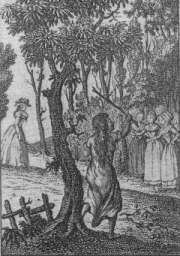Ethnicity Native American Religion Roman Catholic | Known for feral child Name Marie-Angelique Le | |
 | ||
Full Name Birth name unknown Born 1712 French Louisiana, today part of Wisconsin, United States Died December 15, 1775(1775-12-15) (aged 63)
Paris, France Other names The Wild Girl of Champagne
The Maid of Chalons
The Wild Child of Songy | ||
Marie-Angelique Memmie Le Blanc (born 1712 Wisconsin, French Louisiana; died 1775 Paris, France) was a famous feral child of the 18th century in France who was known as The Wild Girl of Champagne, The Maid of Chalons, or The Wild Child of Songy.
Contents
Her case is more controversial than that of some other feral children because a few prominent modern-day scholars have regarded it as either wholly or partly fictional. However, in 2004, the French surgeon-scholar Serge Aroles concluded it was authentic after spending ten years carrying out archival research into Marie-Angelique's life.
Aroles found evidence that Marie-Angelique had survived for ten years living wild in the forests of France, between the ages of nine and 19, before she was captured by villagers in Songy in Champagne in September 1731. He discovered that she had been born in 1712 as a Native American of the Meskwaki (or "Fox") people in what today is the Midwestern U.S. state of Wisconsin and that she died in Paris in 1775, aged 63. Aroles demonstrated also that she learned to read and write as an adult, thus making her unique among feral children.
Contemporary accounts
The story of Marie-Angelique's life in the wild was publicised in the mid-18th century in both France and in Britain through a short pamphlet biography of her by the French writer Marie-Catherine Homassel Hecquet edited by the French scientist-explorer Charles-Marie de la Condamine and published in Paris in 1755. This appeared in an English translation in 1768 as An Account of a Savage Girl, Caught Wild in the Woods of Champagne. However, it was not error-free since it gave Marie-Angelique's age at the time of her capture as ten although it is now known to have been nineteen.
Interviews with Marie-Angelique herself were recorded by the French royal courtier and diarist Charles-Philippe d’Albert, Duc de Luynes (1753), the French poet Louis Racine (c. 1755) and the Scottish philosopher-judge James Burnett, Lord Monboddo (1765). In addition, accounts of her were published by the French naturalists Georges-Louis Leclerc, Comte de Buffon (1759) and Jacques-Christophe Valmont de Bomare (1768), Lord Monboddo (1768) (1773) and (1795), the Chalons lawyer-antiquary Claude-Remy Buirette de Verrieres (1788) and the French historian Abel Hugo (1835).
Modern assessments
The story of Marie-Angelique's life remains little-known in English-speaking countries and appeared to had been almost forgotten in France until quite recently. It was featured in broadcasts by the French radio channel Europe1 in 2011 and by the France Inter channel in 2012.
The French surgeon-author Serge Aroles summarises Marie-Angelique's life in his second book, L’Enigme des enfants-loups: Une certitude biologique mais un deni des archives 1304–1954 (Paris, Editions Publibook, 2007):
These archives [those studied by Aroles himself] prove that the only feral child to have survived in the forests for as long as ten years without irreversible deterioration of body or mind was an Amerindian of the 'Renards' or 'Fox' people. She was brought to France from Canada by a lady who unfortunately arrived [by ship] in Marseille during the bubonic plague epidemic in Provence in 1720.
Having escaped the plague that should have killed her, Marie-Angelique walked thousands of kilometers through the forests of the kingdom of France before being captured in 1731 in the province of Champagne in a state of savagery. During these ten years she did not live with wolves, but survived them by resisting their attacks with a wooden club and another weapon [a long stick with a sharp metal tip] that she either found or stole. When she was captured, this black-skinned, hairy and clawed huntress was showing some characteristics of regression (she knelt down to drink water and had regular sideways eye movements, similar to nystagmus, the result of a life lived in a state of permanent alertness). However, this girl overcame an extreme challenge harder than the cold, wolves, or hunger: she recovered the faculty of human speech after ten years of mutism.
Despite the fact that the archives prove that she was 19 years old when she was captured, a printed text [Hecquet's Histoire d’une jeune fille sauvage] claimed that she was ten. This serious mistake, widely reprinted, blocked for three centuries historians' efforts to discover her origin because it was necessary to look for the records of her birth and arrival in France in older archives. Her intellectual rebirth was important: she learned to read and write, became a nun for a time in a royal abbey, became destitute, was rescued financially by the Queen of France (spouse of Louis XV), refused the love of an educated man, maintained her dignity in the face of her long battle with asthma, and died quite rich, as the inventory of her goods shows.
In January 2015, the Paris publisher Editions Delcourt published a comic book based on Marie-Angelique's life, Sauvage: Biographie de Marie-Angelique le Blanc, written by Jean David Morvan and Aurelie Beviere and illustrated by Gaelle Hersent.
